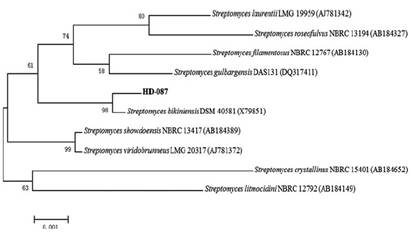Suppression of Fusarium oxysporum and Induced Resistance of Plants Involved in the Biocontrol of Cucumber Fusarium Wilt by Streptomyces bikiniensis HD-087
2012-10-31
Cucumber (Cucumis sativus L.) is one of the most common vegetables worldwide. However, the growth of this plant is often threatened by Cucumber Fusarium Wilt (CFW), a common fungal disease caused by Fusarium oxysporum f. sp. cucumerinum. CFW occurs as a fast epidemic and usually causes severe damage to cucumber quality and productivity. To date, no effective method has yet been found to counteract this disease. The discovery of new and alternative control methods such as biocontrols is therefore urgent.
Many previous studies showed that a few bacteria and fungi can induce systemic resistance of cucumber plants to CFW. However, the response of induced resistance of cucumber plants to CFW is through the activities of actinomycetes and the relevant metabolites are unclear. Metabolites produced by Streptomyces bikiniensis strain HD-087 possess distinctive activity towards CFW fungi and several other plant pathogenic fungi. So researchers investigated the inhibiting effects of HD-087 fermentation broth (‘broth’) against CFW and the quantitative changes in the plant defense-related enzyme activities of peroxidase (POD), phenylalanine ammonia-lyase (PAL), and β-1,3-glucanase induced by HD-087 broth. Moreover, the chlorophyll levels, soluble sugar levels, and relative conductivity of leaves were analyzed to reveal the effects of broth on pathogenesis-related substances in plants.
The result showed that the fermentation broth of HD-087 leads to certain abnormalities in pathogen hyphae. It peroxidizes cell membrane lipids, which leads to membrane destruction along with cytoplasm leakage. This broth also restrains germination of the conidia. The activities of the enzymes peroxidase, phenylalanine ammonia-lyase, and β-1,3-glucanase in cucumber leaves were dramatically increased after treated with fermentation broth of HD-087. The levels of chlorophyll and soluble sugars were also found to be increased, with the relative conductivity of leaves being reduced. In short, the metabolites of strain HD-087 can effectively suppress F. oxysporum and trigger induced resistance in cucumber.
The result has been published on World Journal of Microbiology and Biotechnology, 2012, 28: 2919-2927. The paper can be downloaded from http://www.springerlink.com/index/547610N1235275K4.pdf.

Neighbor-joining phylogenetic tree based on 16S rRNA gene sequences, showing the position of strain HD-087 (in bold) among other Streptomyces species. Numbers at nodes indicate bootstrap values (expressed as percentages of 1,000 replications); Scale bar = 0.001 substitutions per nucleotide position. (Image by XIEG)



